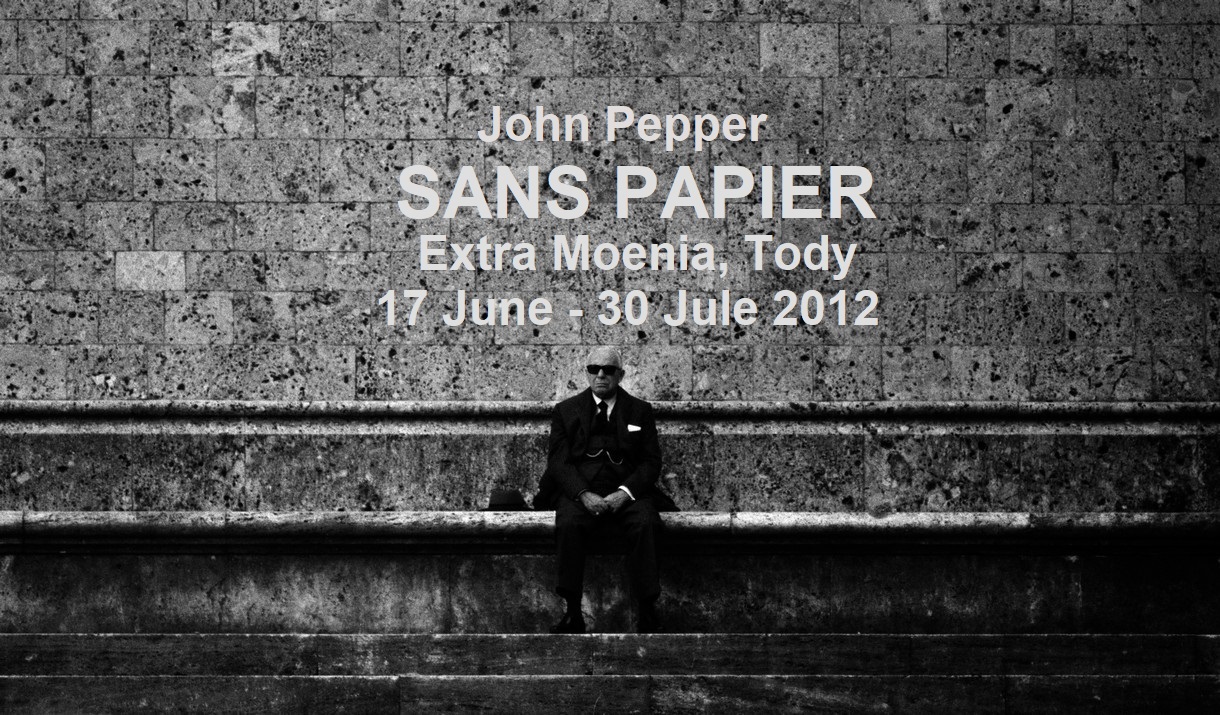'SANS PAPIER'
Extra Moenia, Tody
17 June - 30 July 2012

For John Pepper
When talking about photography, we’re talking about time. The image is fixed in time. We also talk about black and white and color, digital and film, reality and punctum – the critical concept of the French philosopher Roland Barthes, denoting the wounding, personally touching detail, which establishes a direct relationship with the object or person within it.
Is a photographer an artist or not? The ones who feel they are, modestly define themselves as artisans. Still others, who do not think of themselves as photographers will snap photos relying on destiny’s outcome. Finally, there are the ones who fantasize conceptual sequences snapped in extravagant situations -- most of which without interest.
About photography, much has been said. There are established masters, schools of thought, and many hopes. Yet whoever is sufficiently open to a vision within himself, who has cherished and assimilated the masters, will emerge with something new. Passion triumphs when backed by culture.
When looking at one of John Pepper’s photographs -- the one with the group of people, friends and family, in front of their home, for example -- I think of Paul Strand’s image in his book, published with Zavattini ‘Un paese’ del 1955. There is a similar gathering of characters at the doorstep of their home. Time here is not just in the shutter time and lens aperture - -a sixtieth of a second at eight-- but in the transformation of the people, in the process of revealing themselves. With John, however, the appearances differ from those of Strand -- moved up in time as evident in the shoes and pants, the motorcycle helmet, the technology of the wheelchair and the modern necklace of the young girl.
They appear happy and to be speaking to the photographer. Despite some apparently expensive upper-class possessions, we perceive they are of a modest condition. In Strand’s photograph, there is no doubt they are of peasant culture. Motionless, they stare at the photographer with a serious gaze, though ignorant of the world of images. Today, image is consumerism. It goes beyond diffidence. Everyone can have a camera, a motorcycle helmet and Nike shoes. People are well nurtured; they have even grown in height.
With John the scene is of movement. The characters interact with ease, and the photographer is part of the game. He uses black and white film enhanced by the fine art of printing -- images stemming from classical photography.
John was just a boy when he came to my house in Milan, in piazza Castello, above the studio that once belonged to Ugo. I like to think that the darkroom at that time influenced him. Who knows? However, I do believe that Ugo’s work helped him to become a photographer.
His reportage in Italy is filtered through the memory of many great photographers -- Diane Arbus, Cartier Bresson, Robert Frank, the first Richard Avedon, and William Klein to name a few.
He has also traveled through Italy, in the streets and byways of youth, finding dramatic, enlightened faces in the theater of life.
His portrait of the religious procession is most beautiful, with a perfect, compact, composition, among astonished angels and those bearing a religious float against a sharp background of light.
John lives and works in Palermo, an outward antithesis of New York. An American born and raised in Italy, it is as an Italian that he grasps the vital spirit, the soul, and the humanity of people. His choice to live in a region like Sicily, so full of contradictions and archaic values, will surely help him in chronicling the history of change in our era.
Then, apart from making art, he will have absorbed it as his own -- a part of his life that will recur in defining time, space, and the evolution of the human condition.
ANTONIA MULAS
Tody, May 5, 2012